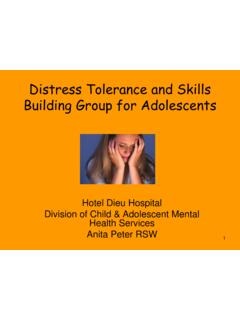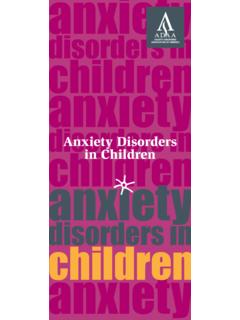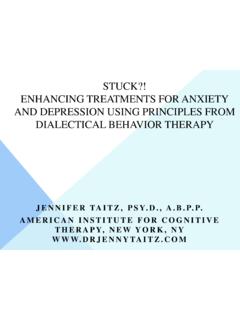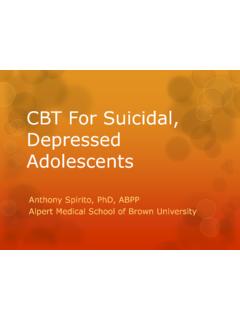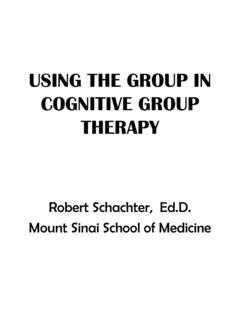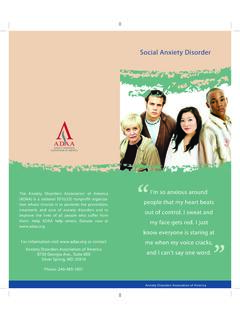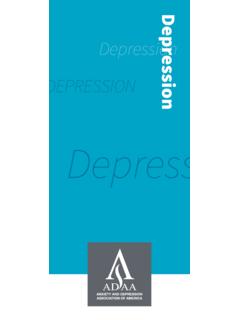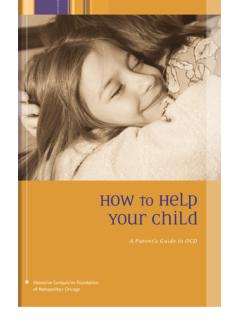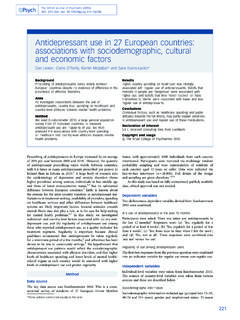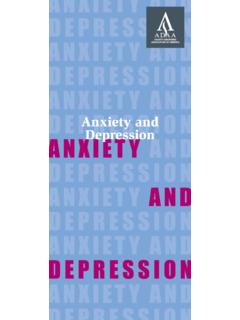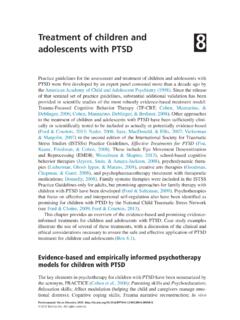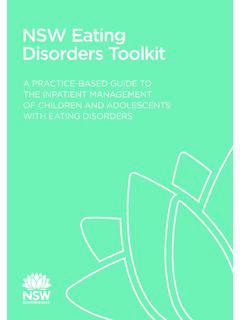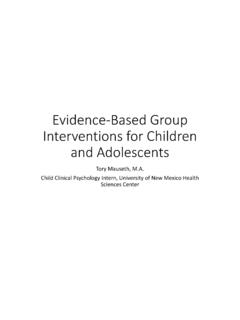Transcription of Social Anxiety Disorder - Anxiety and Depression ...
1 Social ed Anxiety DisorderSocial Anxiety DisorderSocialSocial AnxietySocial Anxiety Disorder23 Social Anxiety Disorder Everyone can relate to feeling anxious before giving a presentation, asking someone out on a date, or going on a job interview. Butterflies in your stomach, sweaty palms, pounding heart all of these are normal feelings in a new or intimidating Social situation. But for more than 15 million American adults, this Anxiety causes extreme self-consciousness in everyday Social or performance situations. Their Anxiety about being scrutinized and negatively evaluated is so severe that they become overwhelmed with fear. This happens in what others consider nonthreatening Social interactions having a conversation, ordering food in a restaurant, signing their name in public, or making a phone call.
2 When Anxiety occurs in these situations and results in significant distress, impairment, or avoidance, it is referred to as Social Anxiety Anxiety Disorder is not simply medicalized shyness. It is a disabling Disorder characterized by overwhelming Anxiety and excessive self-consciousness in everyday Social or performance are some common signs or symptoms of Social Anxiety Disorder : Fear of being visibly nervous in front of others Extreme anticipatory Anxiety about Social interactions and performance situations, such as speaking to a group Fear of not knowing what to say Avoiding face-to-face interactions by depending on technology Fear of eating in public Using alcohol or marijuana to function in Social situationsPeople with Social Anxiety Disorder of have strong physical symptoms before or during Social situations, which may include blushing, sweating, trembling, nausea, heart palpitations, chest discomfort, shortness of breath, dizziness, or Anxiety VS.
3 Social Anxiety DISORDERAn important part of living, Anxiety is a normal emotional reaction to stress. Anxiety helps us get out of harm s way and prepare for important events, and it warns us when we need to take Anxiety is persistent, excessive, seemingly uncontrollable, overwhelming, and disabling or when it interferes with daily activities, you may have Social Anxiety or another Anxiety Disorder . anticipatory anxietyavoidanceSocial Anxiety DisorderoverwhelmingDizzinesssweating45 NORMAL ANXIETYSOCIAL Anxiety DISORDERF eeling anxious prior to making a presentation, leading a meeting, or asking your boss for a raiseTurning down a well-earned promotion that might involve public speaking Feeling shy and awkward when walking into a room full of strangersDreading your office holiday party, experiencing intense Anxiety , and leaving early or avoiding it altogetherButterflies or jitters before a blind dateRefusing a dinner invitation from someone you ve known for years for fear of blushing and embarrassing yourself children AND TEENSC hildren, adolescents.
4 And teens with this Disorder may have few or no friends. They may not participate in class or play at recess. A child who has had trouble making friends or who avoids participating in school and Social activities and shows no sign of improvement may have Social Anxiety Disorder . Family history of Anxiety or Depression increases the risk that this may not be a problem a child will grow out Anxiety Disorder does not just go away, and the consequences often include loneliness, low self-esteem, reduced success in school, Depression , and substance Anxiety Disorder is seen in children of all ages, but it starts more often during the teenage years. Rather than saying they are anxious or afraid, children who are eight or nine years old are more likely to report their physical symptoms and want to avoid most Social situations.
5 Some common physical symptoms of socially anxious children include stomachaches, queasiness or butterflies in the stomach, nausea, blushing, headaches, rapid heartbeat, shortness of breath, dizziness, and dry need to be properly diagnosed and treated early. Social Anxiety Disorder can affect children for years before it is diagnosed. As children grow and mature, they learn how to avoid being the focus of attention at school or home; as a result, their extreme discomfort in Social situations can go intervention and treatment can be very successful, and it may prevent the development of other disorders. It also allows children and teens to function better at school and in their Social participationNausealonelinessqueasinessd ry mouthpersistent67 Social Anxiety Disorder AND OTHER DISORDERS In addition to Social Anxiety Disorder , the term Anxiety Disorder includes generalized Anxiety Disorder (GAD), panic Disorder and panic attacks, agoraphobia, selective mutism, separation Anxiety Disorder , and specific Disorder (OCD) and posttraumatic stress Disorder (PTSD) are closely related to Anxiety disorders; Anxiety is one of their primary symptoms.
6 Some people may experience either of these disorders along with Depression and other related disorders at the same time; Depression is a common co-occurring Disorder . Each Disorder has specific symptoms, and treatment for all disorders is effective. For more details, visit the ADAA website at SELECTIVE MUTISMO ften co-existing with Social Anxiety Disorder is selective mutism. People with this Anxiety Disorder are capable of speech, but they do not speak in some situations or to some people. This Disorder is usually first noticed when a child starts attending school, including preschool, and children with the Disorder do not necessarily improve with age. Without treatment , selective mutism interferes with school and friendships and causes significant stress and upset within a family.
7 It can contribute to chronic Depression , further Anxiety , limited progress in school, and other Social and emotional more information about selective mutism, including treatments, visit disorderpanic attacksSocial Anxiety Disordergeneralized Anxiety disorderselective mutismseparation Anxiety disorderspecific phobiasagoraphobia89 EFFECTST hose with Social Anxiety Disorder are at increased risk for Depression , alcohol abuse, and suicide attempts even more so than people who have other Anxiety disorders. They may avoid any situation in which they fear their intense feelings of Anxiety and fear will arise. The Disorder can disrupt family life, reduce self-esteem, and limit work efficiency.
8 People may have few or no Social or romantic relationships, making them feel powerless, alone, or even ashamed. And they re terrified that they will be negatively evaluated by others or that they will embarrass or humiliate themselves. For some, it can be economically devastating because they have difficulty completing school, interviewing and getting a job, and building professional relationships. The Disorder can be selective, too. Some people may have an intense fear of a single circumstance such as talking to a salesperson or making a phone call, but they can be perfectly comfortable in other Social settings or performing in front of an audience. Other people may become anxious in routine activities in which they might be observed: talking to a stranger or an authority figure, participating in meetings or classes, or attending parties or some may have a performance-focused form of Social Anxiety Disorder : an intense fear of giving a presentation in class or at work or performing at a concert or sports event.
9 However, they may be quite comfortable in other Social situations. CAUSESS cientific research suggests that biological, genetic, and environmental factors are all risk factors. The Disorder typically begins around 13 years old, but younger children can also suffer. Those who cry, cling, or fail to speak in Social situations with other children may be suffering. children and teens will not simply grow out of this Disorder . If signs and symptoms persist, it s important to get a Most people who seek treatment for Social Anxiety Disorder see significant improvement and enjoy a better quality of life. A mental health professional can provide a diagnosis and individualized treatment plan. Early diagnosis and treatment provide the best hope for preventing the onset of other related variety of treatment options are scientifically proven to be effective.
10 One evidence-based treatment is cognitive-behavioral therapy (CBT), a type of psychological therapy based firmly on research findings. This is a short-term treatment that actively involves people in changing the way they perceive situations and events in their lives and helps them develop skills to better cope with addition, the medications called selective serotonin reuptake inhibitors (SSRIs) have also proved effective in the treatment of Social Anxiety Disorder , and they are often used along with psychological therapies. Also called antidepressants, these prescribed medications should be taken under the supervision of a trained doctor. TreatmentEffectsCausesScientific research suggests that biological, genetic, and environmental factors are all risk factors.
